Essential Nursing Skills Assignment
VerifiedAdded on 2022/08/20
|12
|2256
|10
AI Summary
Contribute Materials
Your contribution can guide someone’s learning journey. Share your
documents today.

1
Essential Nursing skills assignment due on 20th of February 2020
- Student number and cohort
- SpLD sticker if applicable
- Module code and name.
- The actual word count (excluding the front sheet, reference list and appendix, if
any)
- The submission date.
- The module leader’s name.
Essential Nursing skills assignment due on 20th of February 2020
- Student number and cohort
- SpLD sticker if applicable
- Module code and name.
- The actual word count (excluding the front sheet, reference list and appendix, if
any)
- The submission date.
- The module leader’s name.
Secure Best Marks with AI Grader
Need help grading? Try our AI Grader for instant feedback on your assignments.
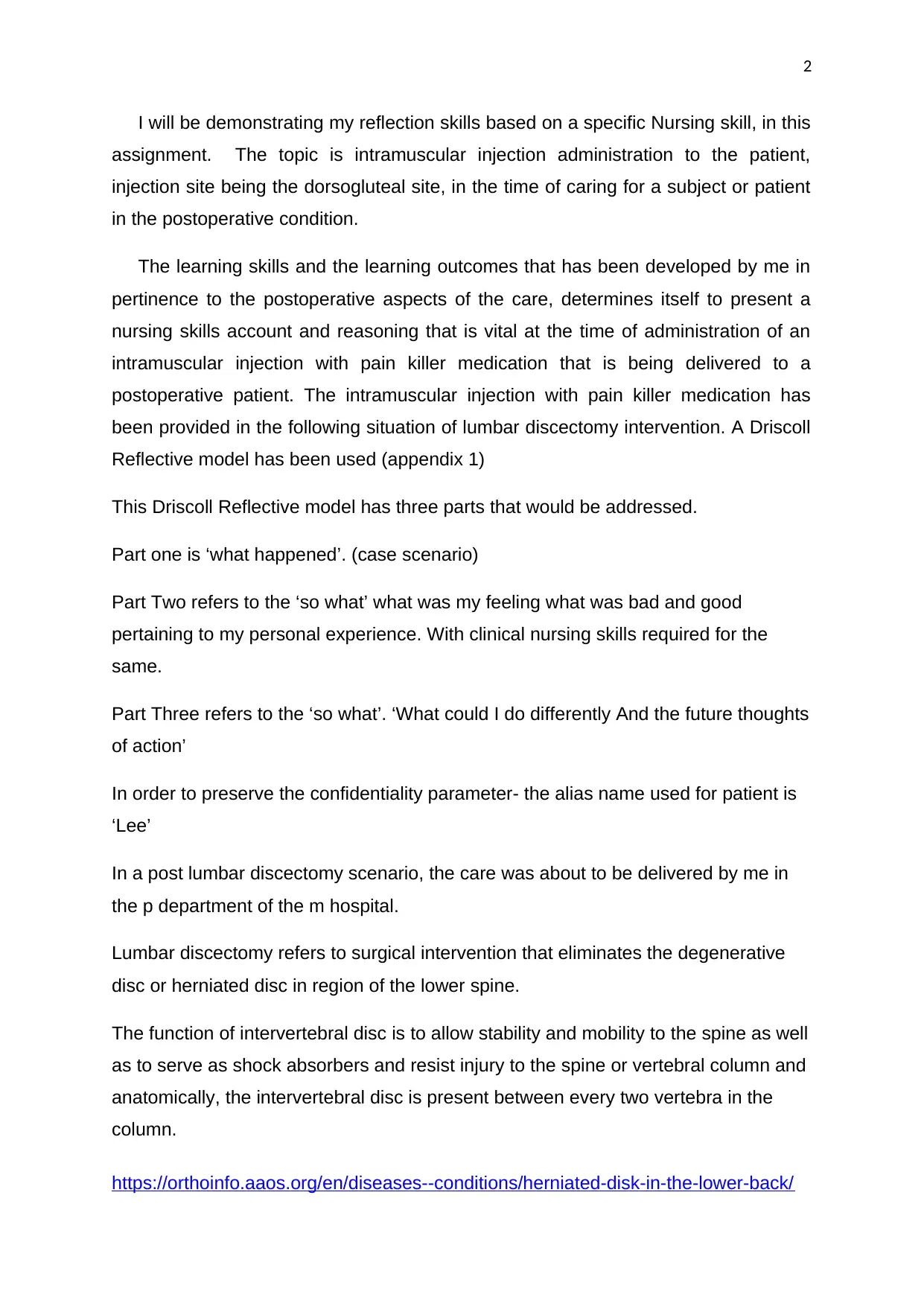
2
I will be demonstrating my reflection skills based on a specific Nursing skill, in this
assignment. The topic is intramuscular injection administration to the patient,
injection site being the dorsogluteal site, in the time of caring for a subject or patient
in the postoperative condition.
The learning skills and the learning outcomes that has been developed by me in
pertinence to the postoperative aspects of the care, determines itself to present a
nursing skills account and reasoning that is vital at the time of administration of an
intramuscular injection with pain killer medication that is being delivered to a
postoperative patient. The intramuscular injection with pain killer medication has
been provided in the following situation of lumbar discectomy intervention. A Driscoll
Reflective model has been used (appendix 1)
This Driscoll Reflective model has three parts that would be addressed.
Part one is ‘what happened’. (case scenario)
Part Two refers to the ‘so what’ what was my feeling what was bad and good
pertaining to my personal experience. With clinical nursing skills required for the
same.
Part Three refers to the ‘so what’. ‘What could I do differently And the future thoughts
of action’
In order to preserve the confidentiality parameter- the alias name used for patient is
‘Lee’
In a post lumbar discectomy scenario, the care was about to be delivered by me in
the p department of the m hospital.
Lumbar discectomy refers to surgical intervention that eliminates the degenerative
disc or herniated disc in region of the lower spine.
The function of intervertebral disc is to allow stability and mobility to the spine as well
as to serve as shock absorbers and resist injury to the spine or vertebral column and
anatomically, the intervertebral disc is present between every two vertebra in the
column.
https://orthoinfo.aaos.org/en/diseases--conditions/herniated-disk-in-the-lower-back/
I will be demonstrating my reflection skills based on a specific Nursing skill, in this
assignment. The topic is intramuscular injection administration to the patient,
injection site being the dorsogluteal site, in the time of caring for a subject or patient
in the postoperative condition.
The learning skills and the learning outcomes that has been developed by me in
pertinence to the postoperative aspects of the care, determines itself to present a
nursing skills account and reasoning that is vital at the time of administration of an
intramuscular injection with pain killer medication that is being delivered to a
postoperative patient. The intramuscular injection with pain killer medication has
been provided in the following situation of lumbar discectomy intervention. A Driscoll
Reflective model has been used (appendix 1)
This Driscoll Reflective model has three parts that would be addressed.
Part one is ‘what happened’. (case scenario)
Part Two refers to the ‘so what’ what was my feeling what was bad and good
pertaining to my personal experience. With clinical nursing skills required for the
same.
Part Three refers to the ‘so what’. ‘What could I do differently And the future thoughts
of action’
In order to preserve the confidentiality parameter- the alias name used for patient is
‘Lee’
In a post lumbar discectomy scenario, the care was about to be delivered by me in
the p department of the m hospital.
Lumbar discectomy refers to surgical intervention that eliminates the degenerative
disc or herniated disc in region of the lower spine.
The function of intervertebral disc is to allow stability and mobility to the spine as well
as to serve as shock absorbers and resist injury to the spine or vertebral column and
anatomically, the intervertebral disc is present between every two vertebra in the
column.
https://orthoinfo.aaos.org/en/diseases--conditions/herniated-disk-in-the-lower-back/
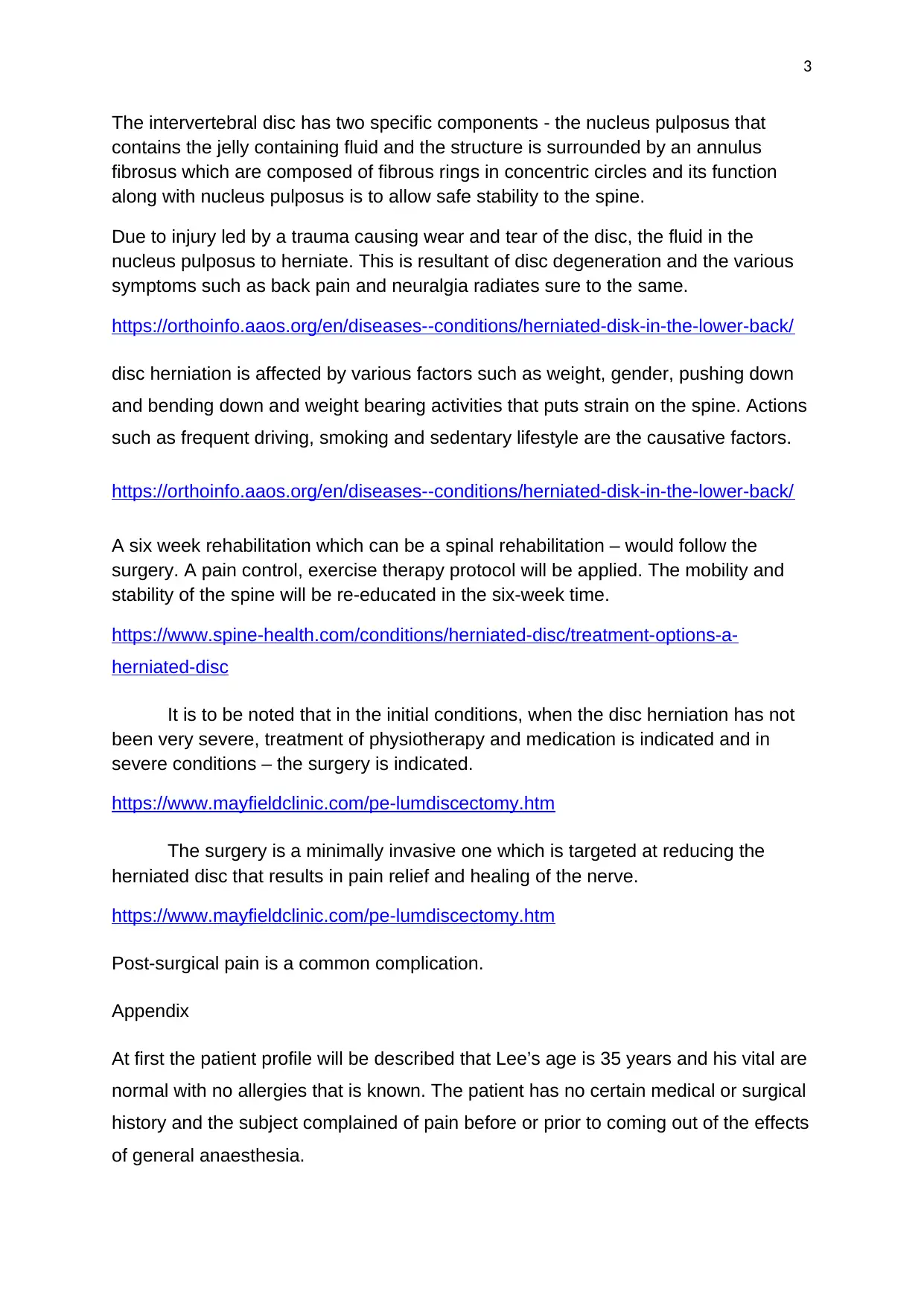
3
The intervertebral disc has two specific components - the nucleus pulposus that
contains the jelly containing fluid and the structure is surrounded by an annulus
fibrosus which are composed of fibrous rings in concentric circles and its function
along with nucleus pulposus is to allow safe stability to the spine.
Due to injury led by a trauma causing wear and tear of the disc, the fluid in the
nucleus pulposus to herniate. This is resultant of disc degeneration and the various
symptoms such as back pain and neuralgia radiates sure to the same.
https://orthoinfo.aaos.org/en/diseases--conditions/herniated-disk-in-the-lower-back/
disc herniation is affected by various factors such as weight, gender, pushing down
and bending down and weight bearing activities that puts strain on the spine. Actions
such as frequent driving, smoking and sedentary lifestyle are the causative factors.
https://orthoinfo.aaos.org/en/diseases--conditions/herniated-disk-in-the-lower-back/
A six week rehabilitation which can be a spinal rehabilitation – would follow the
surgery. A pain control, exercise therapy protocol will be applied. The mobility and
stability of the spine will be re-educated in the six-week time.
https://www.spine-health.com/conditions/herniated-disc/treatment-options-a-
herniated-disc
It is to be noted that in the initial conditions, when the disc herniation has not
been very severe, treatment of physiotherapy and medication is indicated and in
severe conditions – the surgery is indicated.
https://www.mayfieldclinic.com/pe-lumdiscectomy.htm
The surgery is a minimally invasive one which is targeted at reducing the
herniated disc that results in pain relief and healing of the nerve.
https://www.mayfieldclinic.com/pe-lumdiscectomy.htm
Post-surgical pain is a common complication.
Appendix
At first the patient profile will be described that Lee’s age is 35 years and his vital are
normal with no allergies that is known. The patient has no certain medical or surgical
history and the subject complained of pain before or prior to coming out of the effects
of general anaesthesia.
The intervertebral disc has two specific components - the nucleus pulposus that
contains the jelly containing fluid and the structure is surrounded by an annulus
fibrosus which are composed of fibrous rings in concentric circles and its function
along with nucleus pulposus is to allow safe stability to the spine.
Due to injury led by a trauma causing wear and tear of the disc, the fluid in the
nucleus pulposus to herniate. This is resultant of disc degeneration and the various
symptoms such as back pain and neuralgia radiates sure to the same.
https://orthoinfo.aaos.org/en/diseases--conditions/herniated-disk-in-the-lower-back/
disc herniation is affected by various factors such as weight, gender, pushing down
and bending down and weight bearing activities that puts strain on the spine. Actions
such as frequent driving, smoking and sedentary lifestyle are the causative factors.
https://orthoinfo.aaos.org/en/diseases--conditions/herniated-disk-in-the-lower-back/
A six week rehabilitation which can be a spinal rehabilitation – would follow the
surgery. A pain control, exercise therapy protocol will be applied. The mobility and
stability of the spine will be re-educated in the six-week time.
https://www.spine-health.com/conditions/herniated-disc/treatment-options-a-
herniated-disc
It is to be noted that in the initial conditions, when the disc herniation has not
been very severe, treatment of physiotherapy and medication is indicated and in
severe conditions – the surgery is indicated.
https://www.mayfieldclinic.com/pe-lumdiscectomy.htm
The surgery is a minimally invasive one which is targeted at reducing the
herniated disc that results in pain relief and healing of the nerve.
https://www.mayfieldclinic.com/pe-lumdiscectomy.htm
Post-surgical pain is a common complication.
Appendix
At first the patient profile will be described that Lee’s age is 35 years and his vital are
normal with no allergies that is known. The patient has no certain medical or surgical
history and the subject complained of pain before or prior to coming out of the effects
of general anaesthesia.
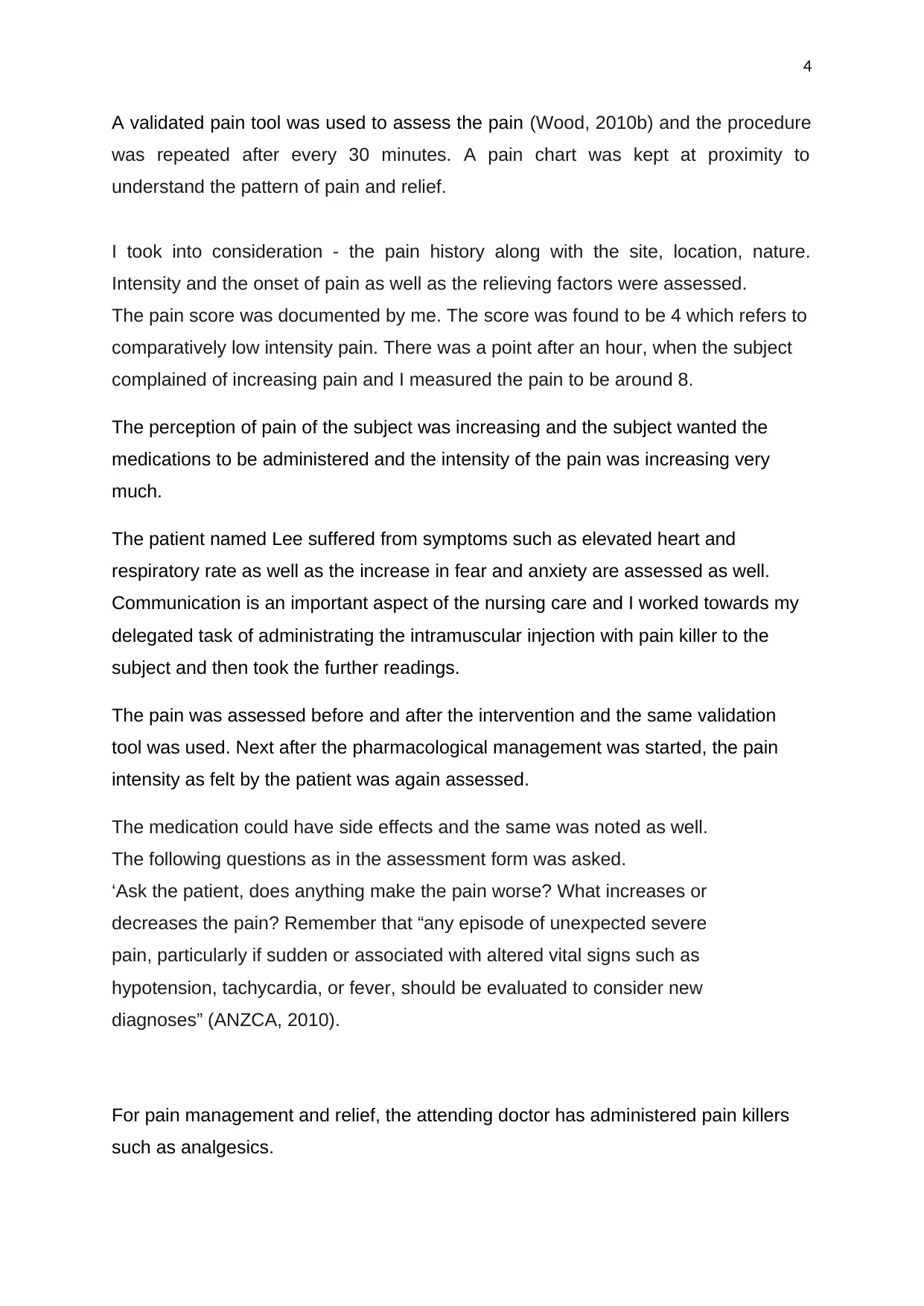
4
A validated pain tool was used to assess the pain (Wood, 2010b) and the procedure
was repeated after every 30 minutes. A pain chart was kept at proximity to
understand the pattern of pain and relief.
I took into consideration - the pain history along with the site, location, nature.
Intensity and the onset of pain as well as the relieving factors were assessed.
The pain score was documented by me. The score was found to be 4 which refers to
comparatively low intensity pain. There was a point after an hour, when the subject
complained of increasing pain and I measured the pain to be around 8.
The perception of pain of the subject was increasing and the subject wanted the
medications to be administered and the intensity of the pain was increasing very
much.
The patient named Lee suffered from symptoms such as elevated heart and
respiratory rate as well as the increase in fear and anxiety are assessed as well.
Communication is an important aspect of the nursing care and I worked towards my
delegated task of administrating the intramuscular injection with pain killer to the
subject and then took the further readings.
The pain was assessed before and after the intervention and the same validation
tool was used. Next after the pharmacological management was started, the pain
intensity as felt by the patient was again assessed.
The medication could have side effects and the same was noted as well.
The following questions as in the assessment form was asked.
‘Ask the patient, does anything make the pain worse? What increases or
decreases the pain? Remember that “any episode of unexpected severe
pain, particularly if sudden or associated with altered vital signs such as
hypotension, tachycardia, or fever, should be evaluated to consider new
diagnoses” (ANZCA, 2010).
For pain management and relief, the attending doctor has administered pain killers
such as analgesics.
A validated pain tool was used to assess the pain (Wood, 2010b) and the procedure
was repeated after every 30 minutes. A pain chart was kept at proximity to
understand the pattern of pain and relief.
I took into consideration - the pain history along with the site, location, nature.
Intensity and the onset of pain as well as the relieving factors were assessed.
The pain score was documented by me. The score was found to be 4 which refers to
comparatively low intensity pain. There was a point after an hour, when the subject
complained of increasing pain and I measured the pain to be around 8.
The perception of pain of the subject was increasing and the subject wanted the
medications to be administered and the intensity of the pain was increasing very
much.
The patient named Lee suffered from symptoms such as elevated heart and
respiratory rate as well as the increase in fear and anxiety are assessed as well.
Communication is an important aspect of the nursing care and I worked towards my
delegated task of administrating the intramuscular injection with pain killer to the
subject and then took the further readings.
The pain was assessed before and after the intervention and the same validation
tool was used. Next after the pharmacological management was started, the pain
intensity as felt by the patient was again assessed.
The medication could have side effects and the same was noted as well.
The following questions as in the assessment form was asked.
‘Ask the patient, does anything make the pain worse? What increases or
decreases the pain? Remember that “any episode of unexpected severe
pain, particularly if sudden or associated with altered vital signs such as
hypotension, tachycardia, or fever, should be evaluated to consider new
diagnoses” (ANZCA, 2010).
For pain management and relief, the attending doctor has administered pain killers
such as analgesics.
Secure Best Marks with AI Grader
Need help grading? Try our AI Grader for instant feedback on your assignments.
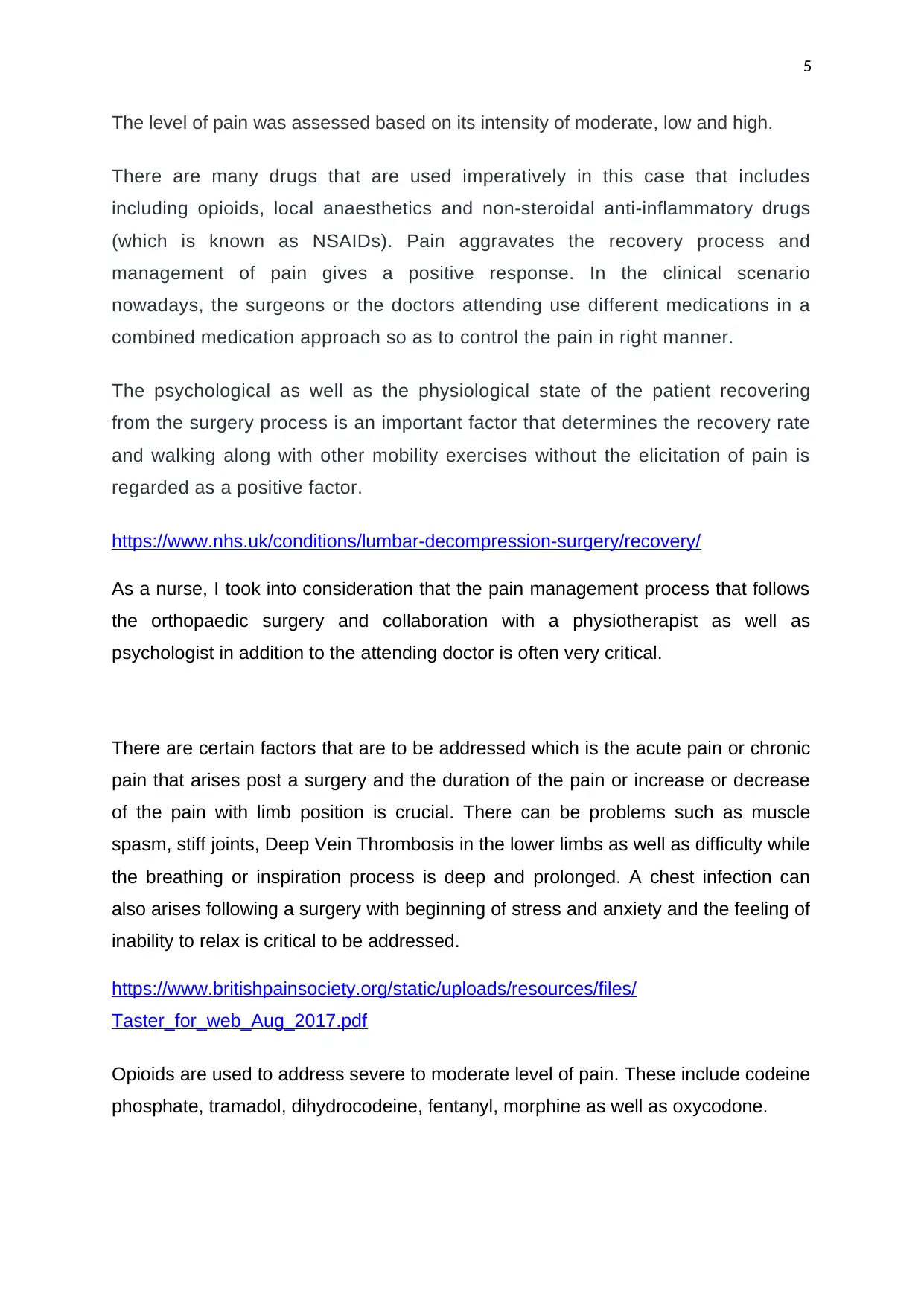
5
The level of pain was assessed based on its intensity of moderate, low and high.
There are many drugs that are used imperatively in this case that includes
including opioids, local anaesthetics and non-steroidal anti-inflammatory drugs
(which is known as NSAIDs). Pain aggravates the recovery process and
management of pain gives a positive response. In the clinical scenario
nowadays, the surgeons or the doctors attending use different medications in a
combined medication approach so as to control the pain in right manner.
The psychological as well as the physiological state of the patient recovering
from the surgery process is an important factor that determines the recovery rate
and walking along with other mobility exercises without the elicitation of pain is
regarded as a positive factor.
https://www.nhs.uk/conditions/lumbar-decompression-surgery/recovery/
As a nurse, I took into consideration that the pain management process that follows
the orthopaedic surgery and collaboration with a physiotherapist as well as
psychologist in addition to the attending doctor is often very critical.
There are certain factors that are to be addressed which is the acute pain or chronic
pain that arises post a surgery and the duration of the pain or increase or decrease
of the pain with limb position is crucial. There can be problems such as muscle
spasm, stiff joints, Deep Vein Thrombosis in the lower limbs as well as difficulty while
the breathing or inspiration process is deep and prolonged. A chest infection can
also arises following a surgery with beginning of stress and anxiety and the feeling of
inability to relax is critical to be addressed.
https://www.britishpainsociety.org/static/uploads/resources/files/
Taster_for_web_Aug_2017.pdf
Opioids are used to address severe to moderate level of pain. These include codeine
phosphate, tramadol, dihydrocodeine, fentanyl, morphine as well as oxycodone.
The level of pain was assessed based on its intensity of moderate, low and high.
There are many drugs that are used imperatively in this case that includes
including opioids, local anaesthetics and non-steroidal anti-inflammatory drugs
(which is known as NSAIDs). Pain aggravates the recovery process and
management of pain gives a positive response. In the clinical scenario
nowadays, the surgeons or the doctors attending use different medications in a
combined medication approach so as to control the pain in right manner.
The psychological as well as the physiological state of the patient recovering
from the surgery process is an important factor that determines the recovery rate
and walking along with other mobility exercises without the elicitation of pain is
regarded as a positive factor.
https://www.nhs.uk/conditions/lumbar-decompression-surgery/recovery/
As a nurse, I took into consideration that the pain management process that follows
the orthopaedic surgery and collaboration with a physiotherapist as well as
psychologist in addition to the attending doctor is often very critical.
There are certain factors that are to be addressed which is the acute pain or chronic
pain that arises post a surgery and the duration of the pain or increase or decrease
of the pain with limb position is crucial. There can be problems such as muscle
spasm, stiff joints, Deep Vein Thrombosis in the lower limbs as well as difficulty while
the breathing or inspiration process is deep and prolonged. A chest infection can
also arises following a surgery with beginning of stress and anxiety and the feeling of
inability to relax is critical to be addressed.
https://www.britishpainsociety.org/static/uploads/resources/files/
Taster_for_web_Aug_2017.pdf
Opioids are used to address severe to moderate level of pain. These include codeine
phosphate, tramadol, dihydrocodeine, fentanyl, morphine as well as oxycodone.
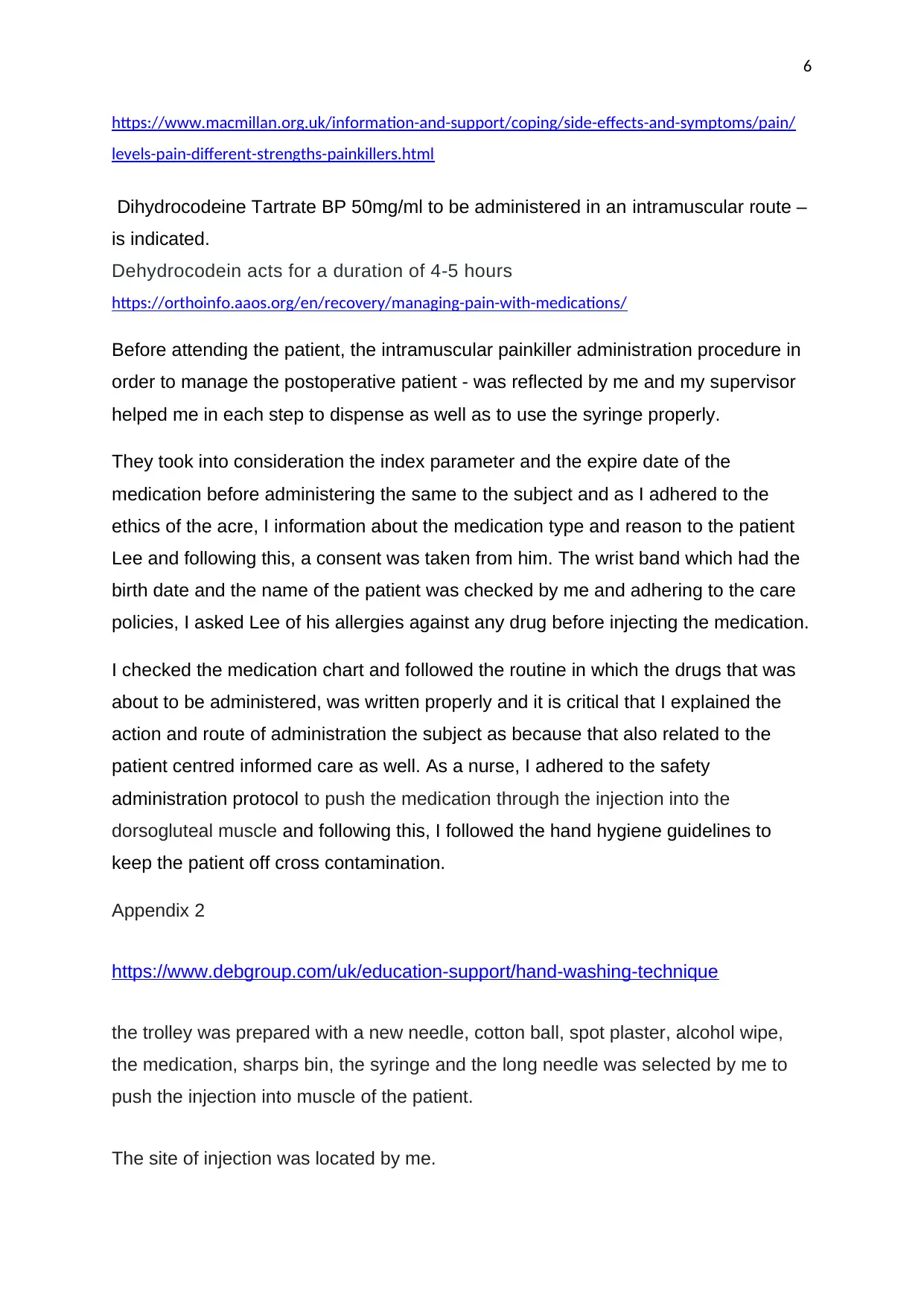
6
https://www.macmillan.org.uk/information-and-support/coping/side-effects-and-symptoms/pain/
levels-pain-different-strengths-painkillers.html
Dihydrocodeine Tartrate BP 50mg/ml to be administered in an intramuscular route –
is indicated.
Dehydrocodein acts for a duration of 4-5 hours
https://orthoinfo.aaos.org/en/recovery/managing-pain-with-medications/
Before attending the patient, the intramuscular painkiller administration procedure in
order to manage the postoperative patient - was reflected by me and my supervisor
helped me in each step to dispense as well as to use the syringe properly.
They took into consideration the index parameter and the expire date of the
medication before administering the same to the subject and as I adhered to the
ethics of the acre, I information about the medication type and reason to the patient
Lee and following this, a consent was taken from him. The wrist band which had the
birth date and the name of the patient was checked by me and adhering to the care
policies, I asked Lee of his allergies against any drug before injecting the medication.
I checked the medication chart and followed the routine in which the drugs that was
about to be administered, was written properly and it is critical that I explained the
action and route of administration the subject as because that also related to the
patient centred informed care as well. As a nurse, I adhered to the safety
administration protocol to push the medication through the injection into the
dorsogluteal muscle and following this, I followed the hand hygiene guidelines to
keep the patient off cross contamination.
Appendix 2
https://www.debgroup.com/uk/education-support/hand-washing-technique
the trolley was prepared with a new needle, cotton ball, spot plaster, alcohol wipe,
the medication, sharps bin, the syringe and the long needle was selected by me to
push the injection into muscle of the patient.
The site of injection was located by me.
https://www.macmillan.org.uk/information-and-support/coping/side-effects-and-symptoms/pain/
levels-pain-different-strengths-painkillers.html
Dihydrocodeine Tartrate BP 50mg/ml to be administered in an intramuscular route –
is indicated.
Dehydrocodein acts for a duration of 4-5 hours
https://orthoinfo.aaos.org/en/recovery/managing-pain-with-medications/
Before attending the patient, the intramuscular painkiller administration procedure in
order to manage the postoperative patient - was reflected by me and my supervisor
helped me in each step to dispense as well as to use the syringe properly.
They took into consideration the index parameter and the expire date of the
medication before administering the same to the subject and as I adhered to the
ethics of the acre, I information about the medication type and reason to the patient
Lee and following this, a consent was taken from him. The wrist band which had the
birth date and the name of the patient was checked by me and adhering to the care
policies, I asked Lee of his allergies against any drug before injecting the medication.
I checked the medication chart and followed the routine in which the drugs that was
about to be administered, was written properly and it is critical that I explained the
action and route of administration the subject as because that also related to the
patient centred informed care as well. As a nurse, I adhered to the safety
administration protocol to push the medication through the injection into the
dorsogluteal muscle and following this, I followed the hand hygiene guidelines to
keep the patient off cross contamination.
Appendix 2
https://www.debgroup.com/uk/education-support/hand-washing-technique
the trolley was prepared with a new needle, cotton ball, spot plaster, alcohol wipe,
the medication, sharps bin, the syringe and the long needle was selected by me to
push the injection into muscle of the patient.
The site of injection was located by me.
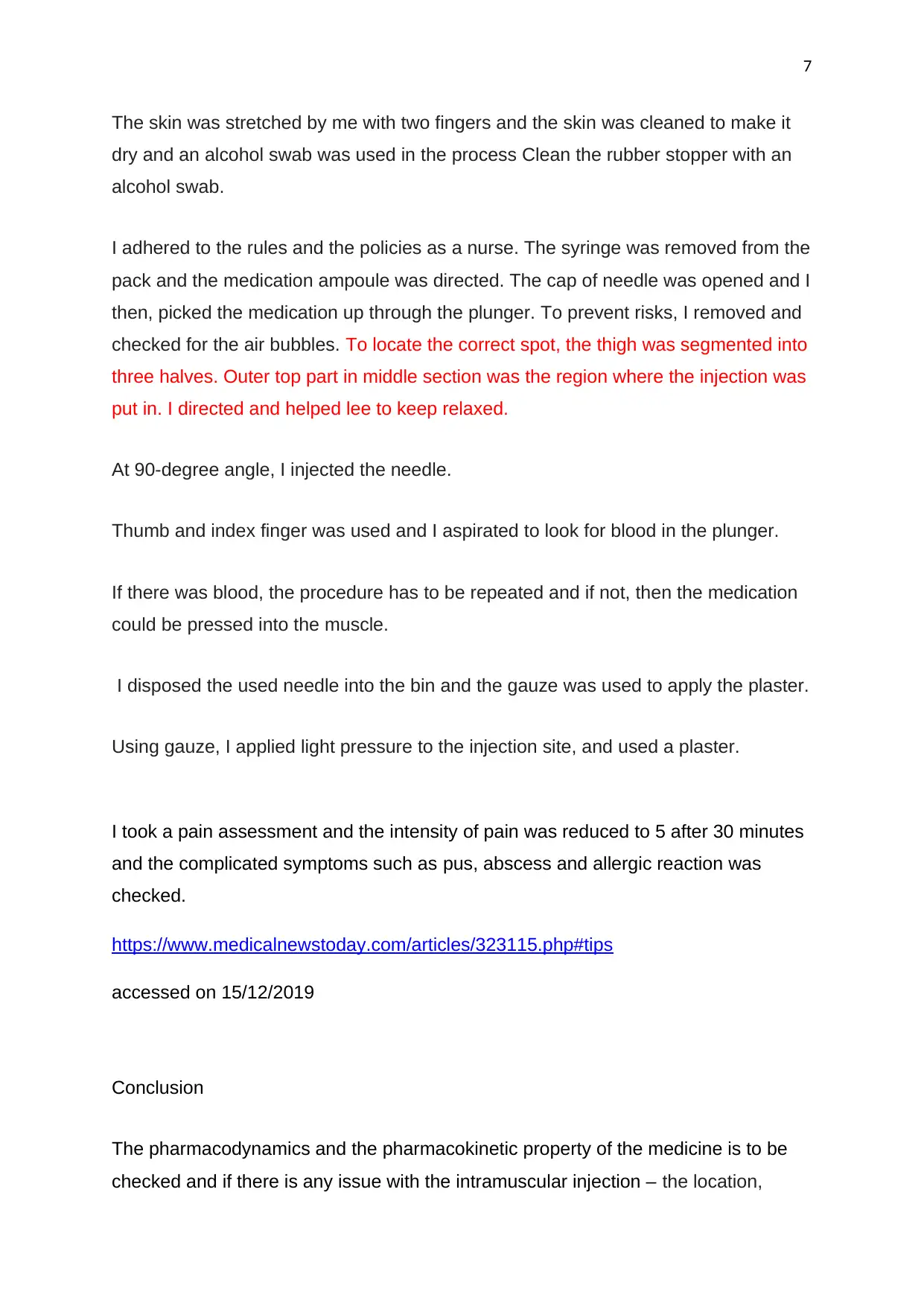
7
The skin was stretched by me with two fingers and the skin was cleaned to make it
dry and an alcohol swab was used in the process Clean the rubber stopper with an
alcohol swab.
I adhered to the rules and the policies as a nurse. The syringe was removed from the
pack and the medication ampoule was directed. The cap of needle was opened and I
then, picked the medication up through the plunger. To prevent risks, I removed and
checked for the air bubbles. To locate the correct spot, the thigh was segmented into
three halves. Outer top part in middle section was the region where the injection was
put in. I directed and helped lee to keep relaxed.
At 90-degree angle, I injected the needle.
Thumb and index finger was used and I aspirated to look for blood in the plunger.
If there was blood, the procedure has to be repeated and if not, then the medication
could be pressed into the muscle.
I disposed the used needle into the bin and the gauze was used to apply the plaster.
Using gauze, I applied light pressure to the injection site, and used a plaster.
I took a pain assessment and the intensity of pain was reduced to 5 after 30 minutes
and the complicated symptoms such as pus, abscess and allergic reaction was
checked.
https://www.medicalnewstoday.com/articles/323115.php#tips
accessed on 15/12/2019
Conclusion
The pharmacodynamics and the pharmacokinetic property of the medicine is to be
checked and if there is any issue with the intramuscular injection – the location,
The skin was stretched by me with two fingers and the skin was cleaned to make it
dry and an alcohol swab was used in the process Clean the rubber stopper with an
alcohol swab.
I adhered to the rules and the policies as a nurse. The syringe was removed from the
pack and the medication ampoule was directed. The cap of needle was opened and I
then, picked the medication up through the plunger. To prevent risks, I removed and
checked for the air bubbles. To locate the correct spot, the thigh was segmented into
three halves. Outer top part in middle section was the region where the injection was
put in. I directed and helped lee to keep relaxed.
At 90-degree angle, I injected the needle.
Thumb and index finger was used and I aspirated to look for blood in the plunger.
If there was blood, the procedure has to be repeated and if not, then the medication
could be pressed into the muscle.
I disposed the used needle into the bin and the gauze was used to apply the plaster.
Using gauze, I applied light pressure to the injection site, and used a plaster.
I took a pain assessment and the intensity of pain was reduced to 5 after 30 minutes
and the complicated symptoms such as pus, abscess and allergic reaction was
checked.
https://www.medicalnewstoday.com/articles/323115.php#tips
accessed on 15/12/2019
Conclusion
The pharmacodynamics and the pharmacokinetic property of the medicine is to be
checked and if there is any issue with the intramuscular injection – the location,
Paraphrase This Document
Need a fresh take? Get an instant paraphrase of this document with our AI Paraphraser
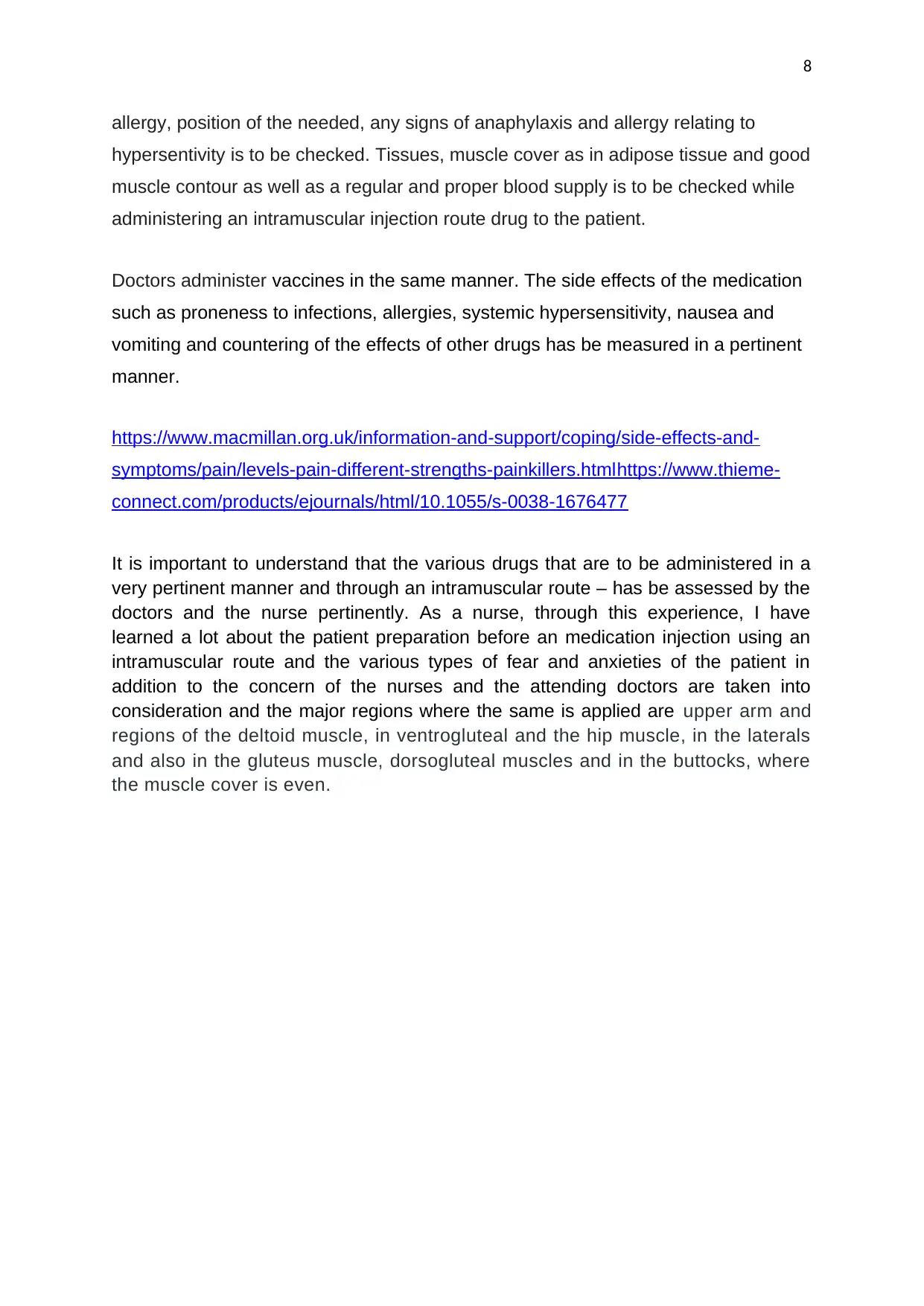
8
allergy, position of the needed, any signs of anaphylaxis and allergy relating to
hypersentivity is to be checked. Tissues, muscle cover as in adipose tissue and good
muscle contour as well as a regular and proper blood supply is to be checked while
administering an intramuscular injection route drug to the patient.
Doctors administer vaccines in the same manner. The side effects of the medication
such as proneness to infections, allergies, systemic hypersensitivity, nausea and
vomiting and countering of the effects of other drugs has be measured in a pertinent
manner.
https://www.macmillan.org.uk/information-and-support/coping/side-effects-and-
symptoms/pain/levels-pain-different-strengths-painkillers.htmlhttps://www.thieme-
connect.com/products/ejournals/html/10.1055/s-0038-1676477
It is important to understand that the various drugs that are to be administered in a
very pertinent manner and through an intramuscular route – has be assessed by the
doctors and the nurse pertinently. As a nurse, through this experience, I have
learned a lot about the patient preparation before an medication injection using an
intramuscular route and the various types of fear and anxieties of the patient in
addition to the concern of the nurses and the attending doctors are taken into
consideration and the major regions where the same is applied are upper arm and
regions of the deltoid muscle, in ventrogluteal and the hip muscle, in the laterals
and also in the gluteus muscle, dorsogluteal muscles and in the buttocks, where
the muscle cover is even.
allergy, position of the needed, any signs of anaphylaxis and allergy relating to
hypersentivity is to be checked. Tissues, muscle cover as in adipose tissue and good
muscle contour as well as a regular and proper blood supply is to be checked while
administering an intramuscular injection route drug to the patient.
Doctors administer vaccines in the same manner. The side effects of the medication
such as proneness to infections, allergies, systemic hypersensitivity, nausea and
vomiting and countering of the effects of other drugs has be measured in a pertinent
manner.
https://www.macmillan.org.uk/information-and-support/coping/side-effects-and-
symptoms/pain/levels-pain-different-strengths-painkillers.htmlhttps://www.thieme-
connect.com/products/ejournals/html/10.1055/s-0038-1676477
It is important to understand that the various drugs that are to be administered in a
very pertinent manner and through an intramuscular route – has be assessed by the
doctors and the nurse pertinently. As a nurse, through this experience, I have
learned a lot about the patient preparation before an medication injection using an
intramuscular route and the various types of fear and anxieties of the patient in
addition to the concern of the nurses and the attending doctors are taken into
consideration and the major regions where the same is applied are upper arm and
regions of the deltoid muscle, in ventrogluteal and the hip muscle, in the laterals
and also in the gluteus muscle, dorsogluteal muscles and in the buttocks, where
the muscle cover is even.
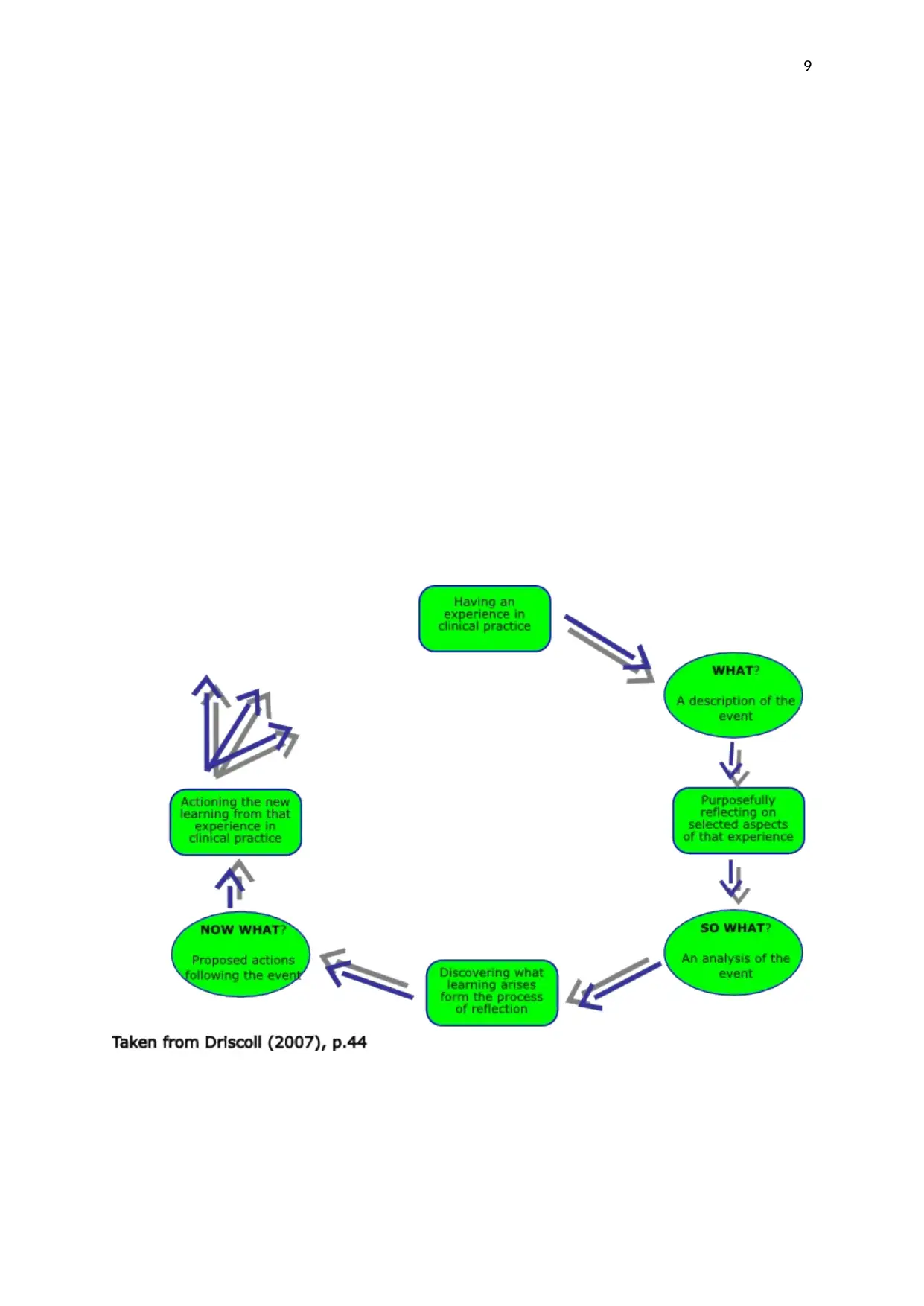
9
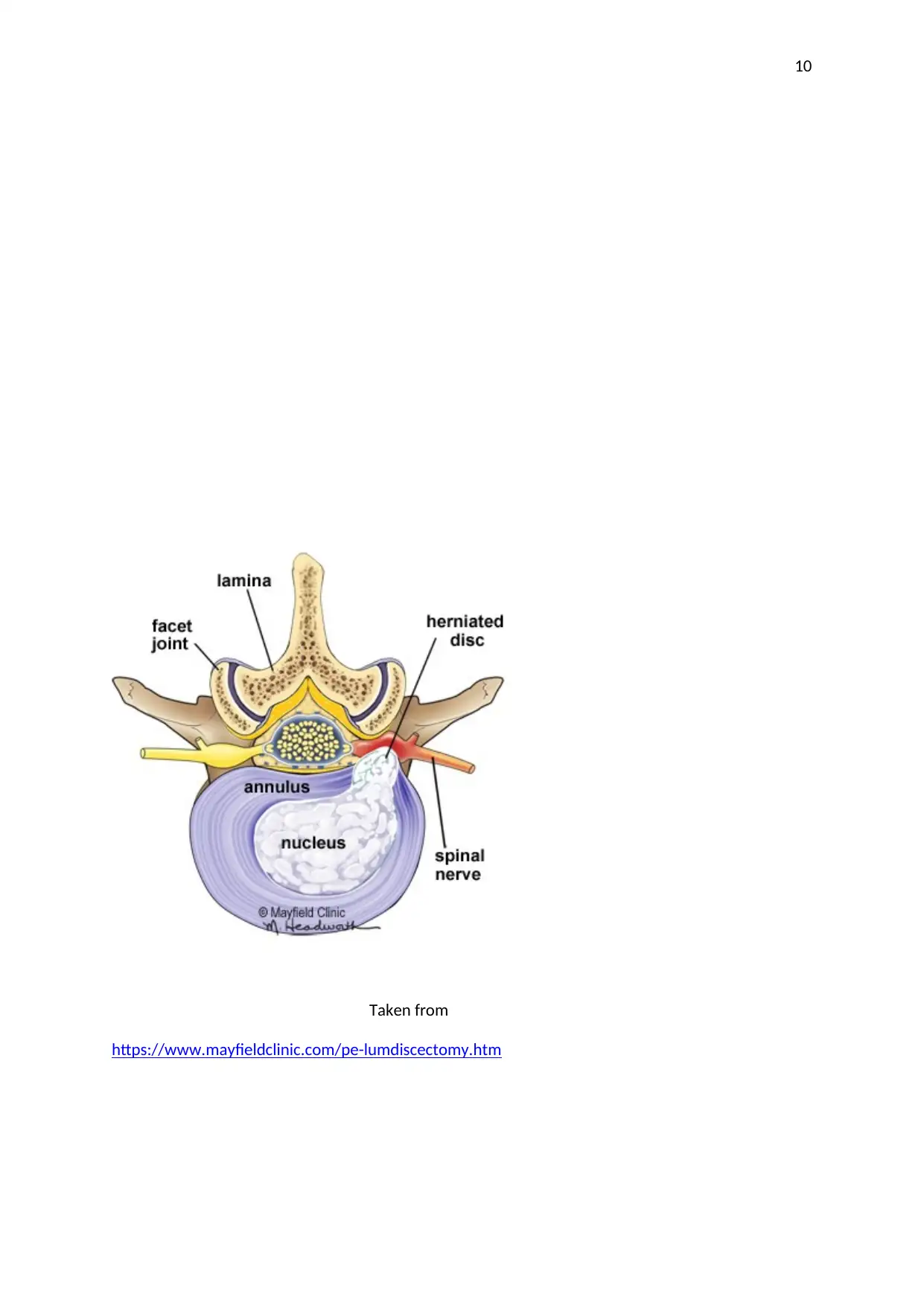
10
Taken from
https://www.mayfieldclinic.com/pe-lumdiscectomy.htm
Taken from
https://www.mayfieldclinic.com/pe-lumdiscectomy.htm
Secure Best Marks with AI Grader
Need help grading? Try our AI Grader for instant feedback on your assignments.
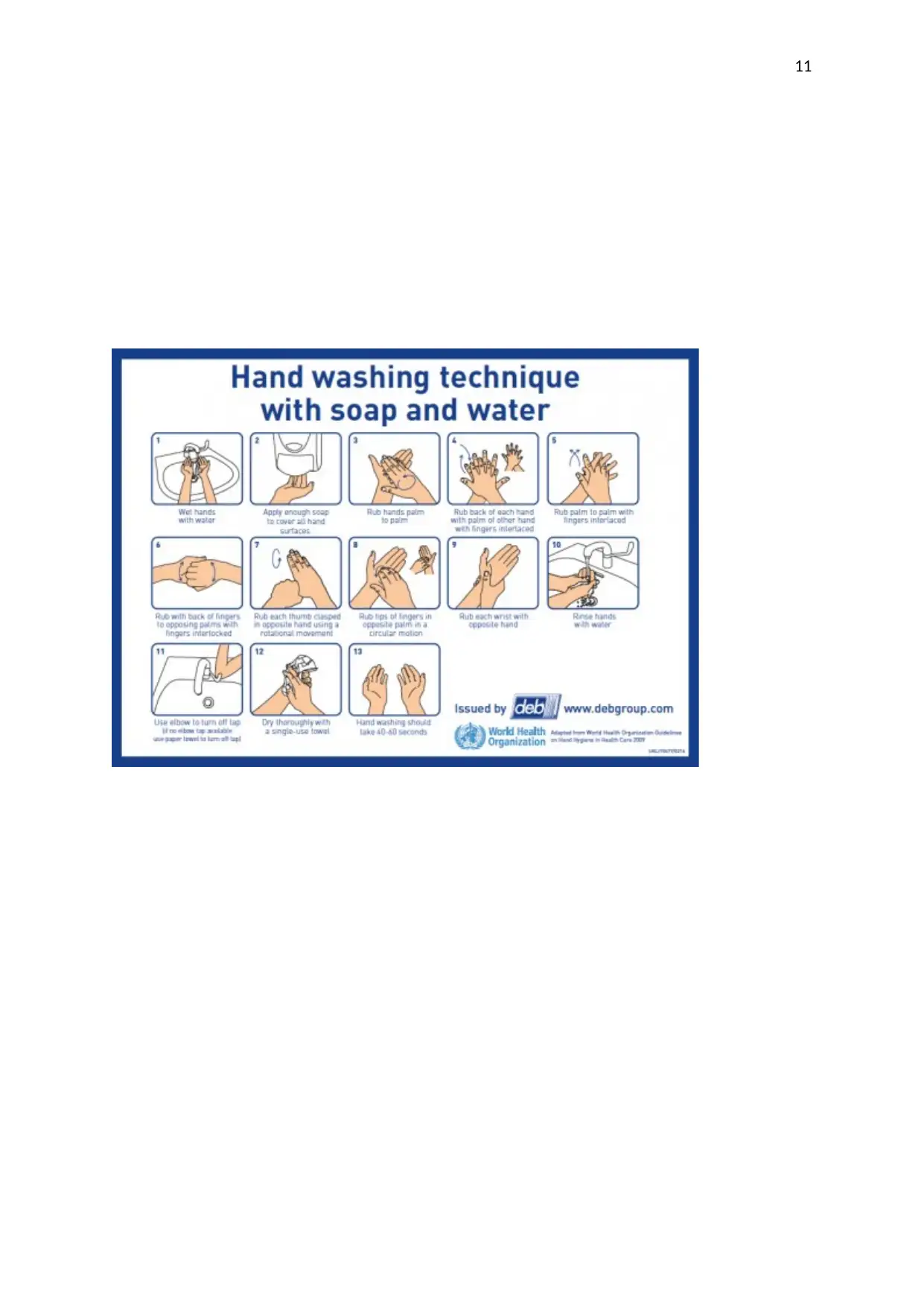
11
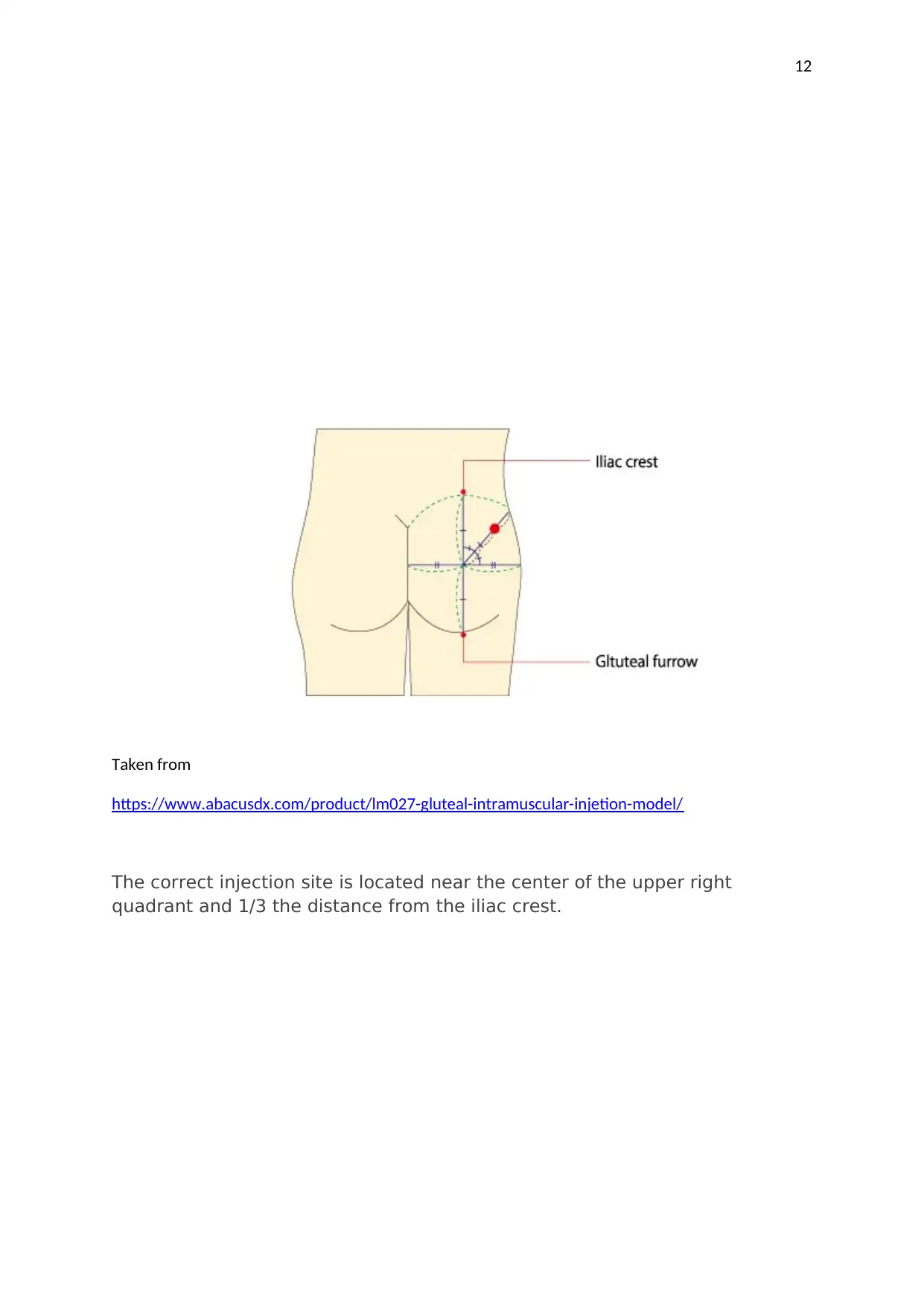
12
Taken from
https://www.abacusdx.com/product/lm027-gluteal-intramuscular-injetion-model/
The correct injection site is located near the center of the upper right
quadrant and 1/3 the distance from the iliac crest.
Taken from
https://www.abacusdx.com/product/lm027-gluteal-intramuscular-injetion-model/
The correct injection site is located near the center of the upper right
quadrant and 1/3 the distance from the iliac crest.
1 out of 12
Your All-in-One AI-Powered Toolkit for Academic Success.
+13062052269
info@desklib.com
Available 24*7 on WhatsApp / Email
![[object Object]](/_next/static/media/star-bottom.7253800d.svg)
Unlock your academic potential
© 2024 | Zucol Services PVT LTD | All rights reserved.